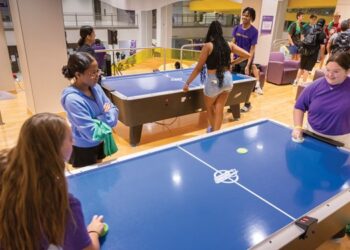There are very few certainties in life. The sun will come up in the morning, you’ll get your tax return a month late, and college students who enjoy working out will come through your doors voluntarily.
These are your regular users, and getting them engaged in your rec center is rarely a problem. The real challenge is engaging non-users, the students who might enjoy being active, but aren’t naturally inclined to seek workout environments.
Successfully engaging non-users will help boost your participation numbers and the culture of your rec center, but it won’t be easy, and you have to start with identifying the non-users on your campus.
“Our approach has been, first and foremost, knowing who our non-users are,” said Rhonda Powers, the director of campus recreation at Northern Arizona University. “We’re very intentional with our programming in order to reach diverse populations.”
Intentionality has worked very well for Northern Arizona’s campus rec department, which has registered high student engagement statistics in recent years.
“Over the last four or five years, we’ve looked at the total reach of our engagement on campus and compared that to total enrollment,” said Powers. “Consistently, we were hitting between 79 and 84 percent engagement. That’s a huge accolade, knowing we’re getting a huge majority of our students involved in some way.”
Not every idea was a homerun in the beginning, however. According to Powers, Northern Arizona started an “incentive-based program” a few years ago called The Bucket List, in which students could check activities off a bucket list and earn prizes.
“The idea was trying to help our students discover new ways and opportunities to learn about themselves, engage their peers in different ways, and expand their experience beyond what they know about themselves,” said Powers. “That didn’t go very well for us, but it shaped our recognition of how important it is to reach all students on a different level by knowing what they like.”
Learning from her mistakes with The Bucket List, Powers pivoted to a new strategy: engaging students on a personal level, pinpointing their interests and crafting programming from that knowledge.
One particular demographic Northern Arizona has seen success in engaging non-users is with the school’s international population.
“We’ve partnered with our international outreach office to bring programs specifically to our international population,” said Powers. “We’ve done a World Cup soccer program to draw in students really interested in soccer, so we can help them build a community and a connection to their new environment.”
Powers also suggests using students’ majors and professional interests as starting points for engaging non-users with your offerings.
“If you’ve got students who are photography or journalism majors, involve them in intramural sports programs by coming out to the games to take pictures, write articles, and post it on our website or social media,” said Powers. “They’re building their portfolios and preparing their futures, but also connecting to recreation in a different way.”
This strategy has paid dividends for Northern Arizona’s participation numbers. “In this past year, our fitness programs jumped up over 20 percent, our intramural sports programs increased over 50 percent and the use of our aquatic center has jumped up over 20 percent,” said Powers.
It’s also important to know you don’t have to do it alone. A diverse student population brings diverse interests, backgrounds and involvement in other campus programs; if there are certain demographics you’d like to engage more, try partnerships with other organizations on campus.
“We look across campus to find different partners we can collaborate with,” said Powers. “We know we have excellent programming and facilities, and we know our partners have target audiences we want to reach, so the question is: How can we achieve the same goal?”
No matter what strategies you choose, however, it’s important to keep your students as the priority. Yes, you’re trying to drive your rec center’s participation numbers, but engaging non-users should be primarily about helping them develop life skills and new interests.
“This all goes beyond recreation,” said Powers. “The key is collaborating across campus, identifying partners and having conversations with them, being intentional in outreach, and always tying things back to the concept of wellness.”
So, ask how you can build intentional partnerships across campus today to engage non-users. “If we start working together as an institution, sharing resources and piggybacking off each other, I think we have a broader and more intentional reach, and the results are much greater,” said Powers.










